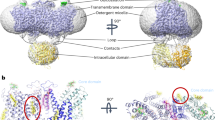Abstract
MK-927 [5,6-dihydro-4H-4(isobutylamino)thieno(2,3-B)thiopyran-2-sulfonamide-7.7 dioxide], a potent carbonic anhydrase inhibitor, contains a chiral center and exists as a racemate. In order to understand the kinetic behavior of the enantiomers of MK-927 in the body, the uptake and binding of these compounds were studied in human erythrocytes in vitro. Since no degradation or metabolism of the enantiomers occurred during incubation in blood, one can describe the equilibration of the drugs between plasma and erythrocytes by a closed two-compartment system. Erythrocytes were considered as a compartment composed of two parts: one in which free drug is exchangeable to plasma and the other in which drug is tightly bound to carbonic anhydrase in a Michaelis–Menten type binding. After the addition of the enantiomers individually to fresh blood, they were taken up by erythrocytes rapidly in a concentration-dependent manner. The time to achieve equilibrium decreased as the concentration increased, suggesting saturation of binding sites. With the assumption of simple diffusion, the binding and transfer kinetics were determined simultaneously by computer fitting. There were no Stereoselective differences in the transfer process of the enantiomers across the erythrocyte membrane, while binding of the enantiomers exhibited stereoselectivity. The penetration of the unbound enantiomer across the erythrocyte cell membrane was rapid, with a mean transit time of about 3 sec. The S-( + )-enantiomer was bound to the high-affinity carbonic anhydrase isoenzyme more strongly than the R-( – )-enantiomer by approximately 10-fold. For the low-affinity isoenzyme, the R-( – )-enantiomer was bound more strongly than the S-( + )-enantiomer.
Similar content being viewed by others
REFERENCES
M. F. Sugrue, P. Gautheron, J. Grove, P. Mallorga, H. Schwam, M. P. Viader, J. J. Baldwin, and G. S. Ponticello. A topically effective ocular hypontensive carbonic anhydrase inhibitors in rabbits. Ophthalmol. Vis. Sci. 29(Suppl.):81 (1988).
M. Diestelhorst, A. Bechetville, E. Lippa, F. Brunner-Ferber, and G. K. Krieglstein. Comparative potencies of the topical carbonic anhydrase inhibitors MK-412 and MK-927. Ophthalmol. Vis. Sci. 30(Suppl.):801–803 (1989).
T. H. Maren. Carbonic anhydrase: chemistry, physiology, and inhibition. Physiol. Rev. 7:595–781 (1967).
J. H. Lin, I.-W. Chen, E. H. Ulm, J. R. Gehret, and D. E. Duggan. Dose-dependent pharmacokinetics of MK-417, a potent carbonic anhydrase inhibitor, in rabbits following single and multiple doses. Drug Metab. Dispos. 18:836–841 (1990).
J. H. Lin, E. H. Ulm, and L. E. Los. Dose-dependent stereo-pharmacokinetics of MK-927, a potent carbonic anhydrase inhibitor, in rats. Drug Metab. Dispos. 19:233–238 (1991).
J. H. Lin, I.-W. Chen, and F. A. deLuna: Dose-dependent pharmacokinetics of MK-417, a potent carbonic anhydrase inhibitor, in experimental polycythmic and anemic rats. Pharm. Res. 8:608–614 (1991).
J. T. Edsall. Some perspectives on carbonic anhydrase since 1960. Ann. N.Y. Acad. Sci. 429:18–25 (1984).
E. E. Rickli, S. A. S. Ghazanfar, B. H. Gibbons, and J. T. Edsall. Carbonic anhydrases from human erythrocytes. Preparation and properties of two enzymes. J. Biol. Chem. 239:1065–1078 (1964).
G. Laurent, M. Charrel, F. Lucciono, M. F. Autran, and Y. Derrien. Surles anhydrase carboniques erythrocytaires humaines. I. Isolement et purilification. Bull. Soc. Chem. Biol. 47:1101–1124 (1965).
E. C. Steiner, G. E. Blau, and G. A. Agin. Introductory Guide to Simusolv, Mitchell and Gouthier Associates, 1986.
D. S. Riggs. The Mathematical Approach to Physiological Problems, M.I.T. Press, London, 1963, pp. 201–203.
J. H. Lin, I.-W. Chen, E. H. Ulm, and D. E. Duggan. Differential renal handling of angiotensin-converting enzyme inhibitors enalpril and lisinopril in rats. Drug Metab. Dispos. 16:392–396 (1988).
G. R. Wilkinson. Clearance approaches in pharmacology. Pharmacol. Rev. 39:1–47 (1987).
H.-J. Lee and W. L. Chiou. Erythrocytes as barriers for drug elimination in the isolated rat liver. I. Doxorubicin. Pharm. Res. 6:833–839 (1989).
H.-J. Lee and W. L. Chiou. Erythrocytes as barriers for drug elimination in the isolated rat liver. II. Propranolol. Pharm. Res. 6:840–843 (1989).
C. A. Goresky, G. G. Bach, and B. E. Nadeau. Red cell carriage of label, its limiting effect on the exchange of materials in the liver. Circ. Res. 36:328–351 (1975).
W. F. Bayne and S. S. Hwang. Effect of nonlinear protein binding on equilibration times for different initial conditions. J. Pharm. Sci. 74:120–123 (1985).
B. Notstrand, I. Vaara, and K. K. Kannan. Structural relationship of human erythrocyte carbonic anhydrase, B and C. Isoenzymes 1:575–599 (1975).
K. K. Kannan, B. Notstrand, K. Fridborg, S. Lovgren, A. Ohlsson, and M. Petef: Crystal structure of human erythrocyte carbonic anhydrase B. Three-dimensional structure at a norminal 2.2 Å. resolution. Proc. Natl. Acad. Sci. 72:51–55 (1975).
W. F. Bayne, L.-C. Chiu, and F. Theeuwes. Acetazolamide binding to two carbonic anhydrase isoenzyme in human erythrocytes. J. Pharm. Sci. 68:912–913 (1979).
P. J. Wistrand and P. Baathe. Inhibition of carbonic anhydrase activity of whole erythrocytes. Acta. Pharmacol. Toxicol. 52:145–160 (1968).
Author information
Authors and Affiliations
Rights and permissions
About this article
Cite this article
Lin, J.H., Lin, TH. & Cheng, H. Uptake and Stereoselective Binding of the Enantiomers of MK-927, a Potent Carbonic Anhydrase Inhibitor, by Human Erythrocytes in Vitro . Pharm Res 9, 339–344 (1992). https://doi.org/10.1023/A:1015886717974
Issue Date:
DOI: https://doi.org/10.1023/A:1015886717974



